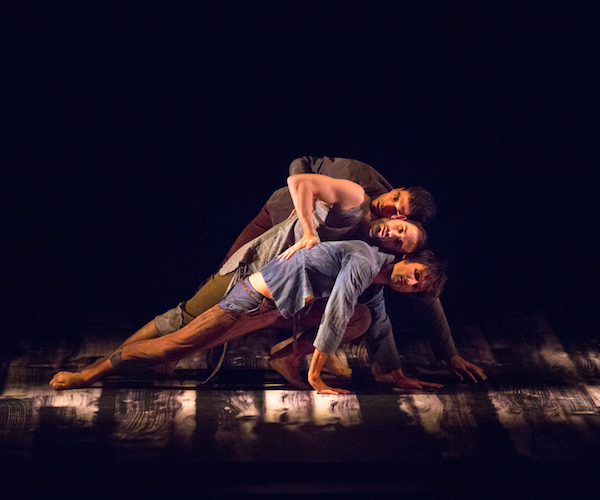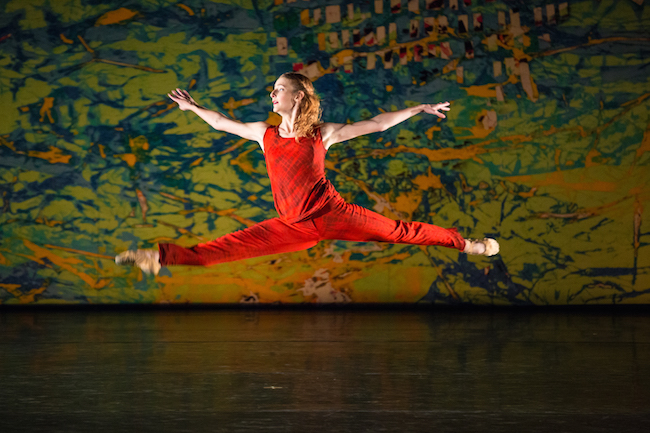Dance Review: L.A. Dance Project — Dancing All Over the Place
All three pieces delivered eclectic dancing, appealing bodies, unostentatious scenic effects, and trendy but serious music.
L.A. Dance Project, presented by Celebrity Series at the Boch Center Shubert Theater, Boston, MA, May 19 through 21.

L.A. Dance Project’s “Harbor Me” (Morgan Lugo, Robbie Moore, Aaron Carr). Photo: Robert Torres.
By Marcia B. Siegel
We’re in a world of fast-moving media and savvy marketing, and Benjamin Millepied’s five-year-old L.A. Dance Project has already gathered impressive kudos. The company, which made its Boston debut Friday night, will be touring pretty much nonstop through the summer and fall. It looks accomplished, decked out in contemporary costumes and musical settings. The Boston programs featured works by three choreographers of varying classical affinities. All three pieces delivered eclectic dancing, appealing bodies, unostentatious scenic effects, and trendy but serious music.
Harbor Me by Sidi Larbi Cherkauoi, a dark piece for three men (Aaron Carr, Morgan Lugo and Robbie Moore), opened the evening. According to the accompanying program info, it was about refugees and outcasts. The music, by Park Woojae, was an eerie series of sounds on the geomungo, a Korean instrument on which Park is an expert player. The music is a bit like a cello, coaxed into wailing, strumming, jittering exclamations.
In the dark, something is stirring on the floor. When the lights come up we can gradually see it’s a man who writhes, twists and falls in perpetual circular motion, with his arms and open jacket flailing. Two other men appear and they revolve together to make intimate but unstable shapes. One man dives between the other two; one lies on the others’ backs; they join their heads together. Elbows bent, hands flat, they play a limitless game of jutting out their hands toward each other without touching. No doubt we should interpret this in terms of the men’s relationship, as we would in a modern dance.
There are other striking events. The jackets are removed, exposing the men’s chests, then replaced. Smoky rays of light pour down from the right and left. A billowy curtain rises at the back. The men keep windmilling and rolling and joining and separating. Finally, one man runs upstage and throws himself at the curtain. The audience responds with adolescent female screams.
After this we saw Justin Peck’s 2013 Murder Ballades. The composer, Bryce Dessner, supplies a note about how, after the killings at Sandy Hook and Aurora, he got interested in the American folk tradition of songs that describe murders. His score, played by the contemporary ensemble Eighth Blackbird, riffs ingeniously on themes from these songs. (I’ve already ordered the album, Filament.)
The curtain had scarcely gone up when you could recognize Peck as a real choreographer, not just a clever maker of movement. First, a bare stage with Sterling Ruby’s backdrop in wide bands of smudgy colors. Small objects on the floor turn out to be sneakers when eight dancers arrive and sit on the floor to put them on.
When they begin to dance, it’s oddly refreshing, after the moody, expressionistic Cherkauoi piece, to see a group of people using the ballet vocabulary in an organized way. You can see the steps clearly, and appreciate the verticality, the extension of a leg into arabesque as it spears out of a fast turn, the lift of the arms, the precise folding in of the leg into passé, the distinction between a flexed and a pointed foot.
Peck allows this classical ballet movement a flexible torso, a freedom in the arms and a lush plié, all of which give the dancer a propulsiveness and a generous access to space. Thus inflected and expanded, classical steps become big swings, turns, slides, and jumps.
Most of the introductory movement is organized into unison groups, but individual dancers streak through with small variations. Before 5 minutes are up, they all back away except Rachel Rafailedes and Nathan B. Makolandra. They sit on the floor side by side and take off their sneakers. They have socks on underneath. They dance, slowly taking the measure of each other, linking together, stepping in tandem, lifting and swinging.
Later on, Peck parses the dancers into another couple — Janie Taylor and Morgan Lugo –and soloists that get displaced by other individuals. There are lineups and gestural flashes from square dance patterns. In an interview somewhere Peck says that although the dance is generally playful, there are sinister undertones that relate it to the music’s grisly subject. I missed the mayhem but the exuberance was fully satisfying.

L.A. Dance Project’s “On the Other Side: (Rachelle Rafailedes) Photo: Robert Torres.
The variability of dynamics is one thing that made Peck’s dance so much more compelling than the metronomic evenness of Millepied’s On the Other Side, which closed the program. A faithful application of 11 piano pieces by Philip Glass, recorded by Maki Namekawa and Paul Barnes, the music was typical Glass: rippling arpeggios with chords above that shape a rudimentary melodic line. I’m not an admirer of Glass, even when he ventures out of his familiar modulations and finger exercises. Like the music, the dance was busy every moment, with curlicues added to simple gestures and people rushing here and there to regroup.
This dance is notable for scenic effects provided by Mark Bradford’s pointillist backdrop, which seems to change color as lights and shadows are projected on it by designer Lucy Carter. Midway, for some reason, a lighting boom drops almost to the floor, with three amber spots that light up a women’s trio. After this number, the boom lifts out again.
Mostly what I remember about On the Other Side is a few episodes meant to convey drama or relationships. Millepied’s movement requires a classical baseline — all dancers have this training nowadays — and the ability to go barefoot, skip, lift each other while running, slowly somersault backwards, gesture soulfully.
A woman in red (Rachel Rafailedes) spins and leaps alone; three other women enter and manipulate her, but they leave and she continues on alone. You don’t know if she wanted to be one of them or if she’d rather go solo. There’s a trio (Stephanie Amurao, Julia Eichten and Aaron Carr) who address the audience with showy jumps, turns, partnering as in a traditional ballet pas de trois, but who use a dance language that’s more made-up than classical. There are two romantic duets for women and one for men. And, later, a melancholic solo for David Adrian Freeland Jr., as Glass turns to a slow minor key. Freeland’s colleagues return and gradually reconnect in lines and clusters, as if to assert their survival in spite of all they’ve been through.
Internationally known writer, lecturer, and teacher Marcia B. Siegel covered dance for 16 years at The Boston Phoenix. She is a contributing editor for The Hudson Review. The fourth collection of Siegel’s reviews and essays, Mirrors and Scrims—The Life and Afterlife of Ballet, won the 2010 Selma Jeanne Cohen prize from the American Society for Aesthetics. Her other books include studies of Twyla Tharp, Doris Humphrey, and American choreography. From 1983 to 1996, Siegel was a member of the resident faculty of the Department of Performance Studies, Tisch School of the Arts, New York University.
